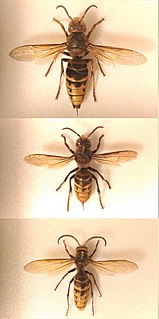
The European hornet is the largest eusocial wasp native to Europe. It is also the only true hornet found in North America, having been introduced by European settlers in the 1800s. V. crabro is usually regarded as a pest by those humans who come into contact with it. Vespines, like V. crabro, are known for making intricate paper-like nests out of surrounding plant materials and other fibers. Unlike most other vespines, reproductive suppression involves worker policing instead of queen pheromone control, as was previously thought.
Nomada verecunda is a species in the family Apidae, in the order Hymenoptera . Nomada verecunda is found in North America.

Hoplitis anthocopoides is a species in the family Megachilidae, in the order Hymenoptera . The distribution range of Hoplitis anthocopoides includes Africa, Europe, Northern Asia, and North America.

The hawthorn miner bee is a species of miner bee in the family Andrenidae which is in the order Hymenoptera. Another common name for this species is hawthorn andrena. It is found in North America.
Colletes simulans is a species in the family Colletidae, in the order Hymenoptera. The species is known generally as the "spine-shouldered cellophane bee". It is found in North America.

Andrena krigiana is a species in the family Andrenidae, in the order Hymenoptera. The species is known generally as the "dwarf-dandelion andrena". It is found in North America.
Stictiella formosa is a species in the order Hymenoptera, in the class Insecta ("insects"). The distribution range of Stictiella formosa includes Central America and North America.

Formica fossaceps is a species of ant in the genus Formica, in the family Formicidae. This species is a member of the Formica rufa species group.

Eremnophila aureonotata, also known as the gold-marked thread-waisted wasp, is a species in the family Sphecidae, in the order Hymenoptera.
Osmia glauca is a species in the genus Osmia, in the family Megachilidae . It is found in North America.
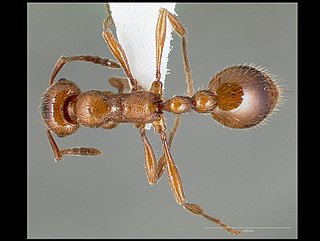
Manica hunteri is a species of ant in the family Formicidae.

Triepeolus is a genus of cuckoo bees in the family Apidae. There are at least 140 described species in Triepeolus.

Formica glacialis is a species of ant in the family Formicidae.
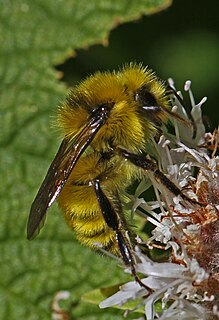
Bombus vandykei, the Van Dyke's bumble bee, is a species of bumble bees in the family Apidae. It is found in North America.
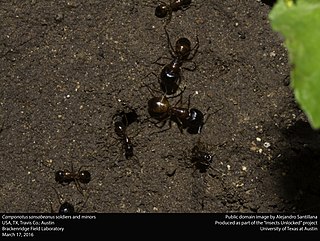
Camponotus sansabeanus is a species of ant in the family Formicidae.
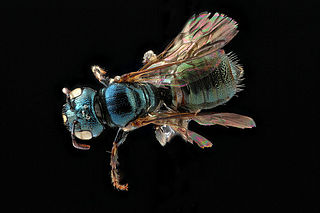
Ceratina strenua, the nimble ceratina, is a species of carpenter bee in the family Apidae. It is found in North America.
Gorytes willcoxi is a species of sand wasp in the family Crabronidae. It is found in North America.
Stelis perpulchra is a species of insect in the family Megachilidae. It is found in Central America and North America.
Crabro cingulatus is a species of square-headed wasp in the family Crabronidae. It is found in Central America and North America.

Dufourea is a genus of sweat bees in the family Halictidae. There are at least 160 described species in Dufourea.












